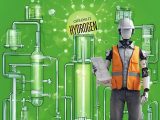
Hydrogen Hubs receiving $8B in federal funds better have their data ready
May 29, 2024 1 By Angie BergensonLawmakers are demanding that the Department of Energy back emissions improvements claims.
The Department of Energy has been ordered by two House Democrats to provide hydrogen hub projected lifecycle emissions reports for seven of the projects receiving federal funds.
The lawmakers are seeking clarification regarding emissions
Representatives Jamie Raskin (D-Maryland) and Don Beyer (D-Virginia) signed a letter sent to the Office of Clean Energy Demonstrations (OCED) at the Department of Energy, requestion clarification regarding the emissions that would result from the $8 billion project funding hydrogen hubs, aiming to boost the production of H2 for uses in cleaner transportation, such as in trucking.
While it is possible for H2 to help avoid carbon emissions, depending on the way it is produced, it doesn’t necessarily mean that greenhouse gas emissions won’t result. This includes in the form of “grid emissions” when electricity is used to power some of the H2 production methods, pointed out the lawmakers in their letter.

Hydrogen hubs can produce lifecycle missions that include CO2
In their letter to the DoE, they wrote that “Scientists have warned that high levels of lifecycle emissions from hydrogen production could entirely cancel out any climate benefits from replacing fossil fuels with hydrogen.” They also pointed out that as of yet, the DoE has only ever published projected greenhouse gas emission savings associated with the hydrogen hubs. That said, they have yet to publish data regarding the emissions associated with operating those facilities.
So far, the federal government hasn’t made it easy for H2 to be considered clean enough to qualify for funding through Clean Hydrogen Production Credit tax credits. In doing so, this eliminated worries that heavily polluting fuels like coal could be used to power H2 producing processes.
However, the rules haven’t been strict enough to stop natural gas (methane) and other fossil fuels from being considered, despite the pollution that they still emit.
Methods with the lowest levels of emissions include electrolysis powered by renewable energy such as solar and wind, and certain types of nuclear H2.
The seven hubs
There will be seven hydrogen hubs in the United States. They were first announced in 2021 but were finalized last year. They are: Pacific Northwest, Midwest, Heartland, Gulf Coast, California, Appalachian and Mid-Atlantic.
About The Author
Long time clean energy enthusiast and writer of many green energy news subjects.
1 Comment
Leave a Reply Cancel reply
This site uses Akismet to reduce spam. Learn how your comment data is processed.



 HFN News is your leading source for fresh hydrogen and renewable energy updates. Amid the fast-paced growth of hydrogen companies, we provide top-notch news and insights about this exciting sector. Our coverage spans from hydrogen cars to global sustainable initiatives, and we highlight the latest in green jobs and developing hydrogen hubs. We invite you to share your local hydrogen news and explore today’s renewable energy job listings on our site. Thanks for choosing HFN News as your trusted guide to the hydrogen and renewable energy world!
HFN News is your leading source for fresh hydrogen and renewable energy updates. Amid the fast-paced growth of hydrogen companies, we provide top-notch news and insights about this exciting sector. Our coverage spans from hydrogen cars to global sustainable initiatives, and we highlight the latest in green jobs and developing hydrogen hubs. We invite you to share your local hydrogen news and explore today’s renewable energy job listings on our site. Thanks for choosing HFN News as your trusted guide to the hydrogen and renewable energy world!

And the alternative of EV uses what exactly? Oh electricity from the grid? Are you saying “grid emissions” do not exist for ev? Your statement shows inherent bias..